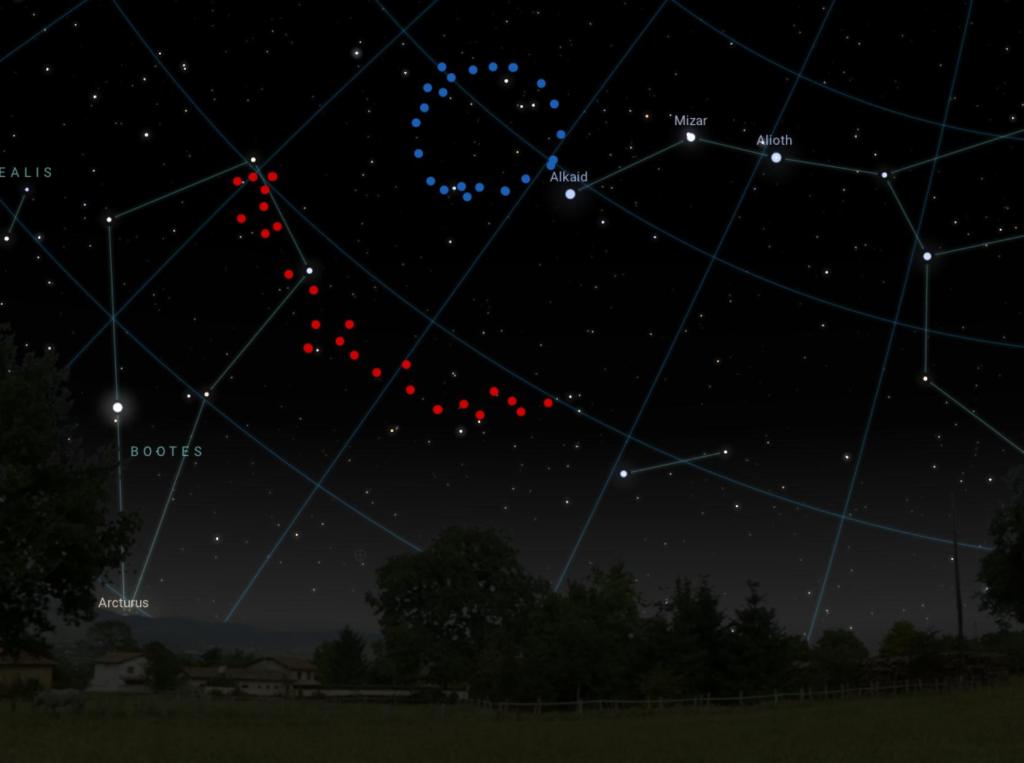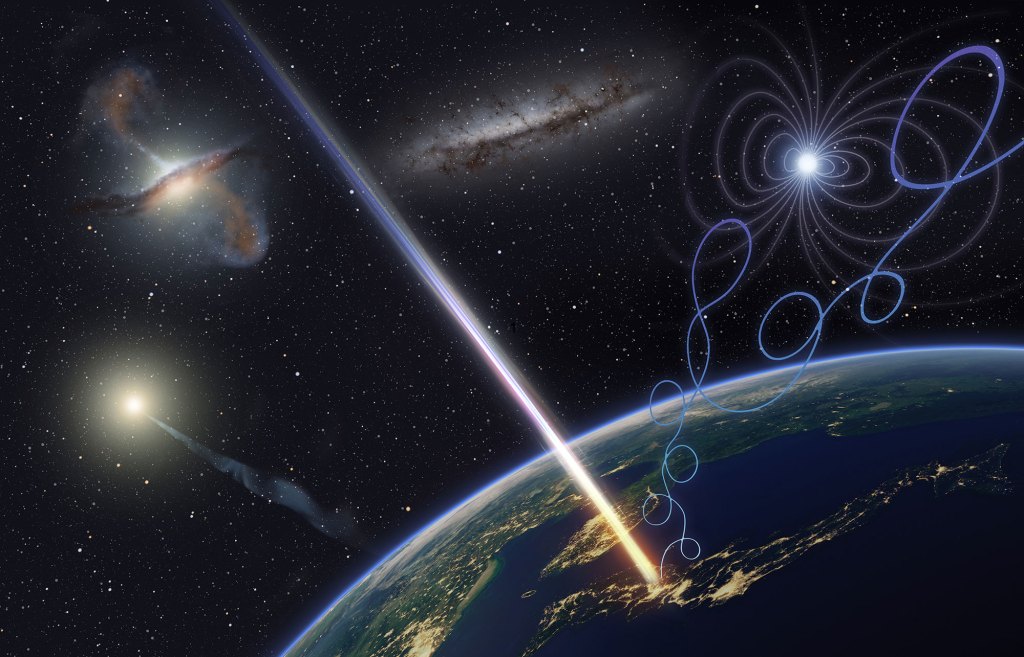Humans across cultures are drawn to the mystery of horizons. This impulse has led to perilous voyages across land, oceans, and into outer space, but it has yet to unlock the secrets of the ultimate boundary: the cosmological horizon, or the edge of the observable universe.
As the name implies, the observable universe is everything that humans can see from Earth with our increasingly sophisticated observatories. As our astronomical vision has improved over the centuries, we’ve discovered that gazing into space is also a form of time travel to the past. If you look at a star like Sirius, which is eight light years away, you are seeing an image of it eight years ago, when the starlight hitting your eye left it. The farther away an object in space is, the more distant in time it is as well, and so the light from stars that died long before our planet was born continues to reach Earth.
Videos by VICE
Such dazzling vistas are enough to keep humans busy with new discoveries as long as we exist. That said, the observable universe that surrounds us is absolutely infinitesimal compared to the dimensions of the broader universe—which may, in fact, be infinite.
This is the part of the universe labeled ‘there be dragons’
There are limits to how far back we can directly look in time due to the glare of the cosmic microwave background (CMB), the oldest light in the universe, which shone when the universe was about 400,000 years old. There are also limits to how far we can look into space due to the cosmological horizon, a boundary that cleaves the observable universe from the unseen expanse outside of it.
What might lie beyond our sight, in the vast unobservable universe? Could it contain exotic physics, new worlds, or even alien lifeforms? And will this hidden realm remain out of reach forever? Read on, but beware—this is the part of the universe labeled “there be dragons.”
What is the cosmological horizon?
Given that the universe is about 13.8 billion years old and light travels at the same speed throughout it, it seems intuitive that the universe’s radius would be 13.8 billion light years. But there’s one thing that can move even faster than light: the expansion of the universe itself.
The universe is expanding at an accelerated rate, which means that light that travels from faraway objects has more ground to cover as the universe grows older and more disparate over time.
“It’s easier for a photon to get from A to B in the early universe than it is in the late universe because in the early universe, A and B were a lot closer to each other,” explained Malcolm Fairbairn, a cosmologist at King’s College London, in a call.
For instance, the CMB is a faint glow we see in all directions that was emitted when the universe was a few hundred thousand years old. While this ancient light was traveling to Earth, its source has been swept farther away from us by the universe’s expansion. Photons from the CMB may be around 13 billion years old, but they are from a region that is now an estimated 46 billion light years from Earth—or 440 “yottameters,” the largest unit in the metric system—assuming that the cosmic inflation rate is constant.
“As soon as people started to realize that the universe was expanding, they started to think about the fact that the distance from which you could receive signals depends upon how the universe has expanded in the past,” Fairbairn said.
That distance is the cosmological horizon, also known as the particle horizon, and it recedes as the universe ages. If intelligent life still exists in our solar system in a billion years, those observers might discover “new” galaxies and stars when their light finally arrives at Earth.
But the cosmological horizon is not the only key boundary that scientists have identified on cosmic scales. One of the quirks of living in an expanding universe is that the more distant an object is, the faster it is receding away from Earth (or any vantagepoint, for that matter). At a certain boundary, called the Hubble horizon or sphere, objects start to retreat faster than the speed of light.
The cosmological horizon is currently wider than the Hubble horizon by a few billion light years. In a trippy twist, this enables us to observe objects that are traveling away from us at “superluminal” velocities that are quicker than light speed.
These objects aren’t moving through space faster than light themselves, which is impossible according to known physics. Rather, spacetime itself is outpacing light speed. This means that if aliens evolved in some distant galaxy that we see beyond the Hubble horizon, but within the cosmological horizon, we would never be able to contact them. Any signal or message we sent, even at the speed of light, could never catch up with the superluminal expansion of space outside of the Hubble horizon.
Are there aliens beyond the cosmological horizon?
Nobody knows what’s beyond the horizon. But theoretically, there’s no reason to think that the universe outside it is radically different from what we see within it.
“From everything that you can do observationally, it’s exactly the same beyond the horizon as it is below the horizon,” Fairbairn said. “People have tried to look to see, for example, if things are gradually changing as we get closer to the horizon and as far as they can tell, there’s no evidence for that whatsoever.”
This predicted coherence between the observable and unobservable universe might be disappointing to people who enjoy dreaming up unfamiliar and exotic realms that lie beyond each new horizon. But this cosmic homogeneity could also lend weight to one of the juiciest ideas in science: the possibility that life has evolved elsewhere in the universe.
For decades, scientists have struggled to square the theoretical probability that alien life exists with the complete lack of observational evidence for this idea, a tension that is known as the Fermi paradox.
Tomonori Totani, an astrophysicist at the University of Tokyo, proposes that the paradox could be addressed by widening the scope of potential “abiogenesis” events, which is the term for the origins of life. Instead of focusing on the emergence of life within the observable universe, he probes the likelihood of abiogenesis in “the whole inflationary universe”—including everything beyond the cosmological horizon—according to a study published in February in Scientific Reports,
“The origin of life is certainly the biggest question in science, and I wanted to think about it from a viewpoint of an astrophysicist,” Totani said in an email. “It was rather natural for me to think about the abiogenesis probability beyond the observable universe, because all astrophysicists studying cosmology know that the real universe’s size is much bigger than the observable universe.”
Indeed, the entire universe may well have no limits at all. From this perspective, it’s no wonder we haven’t found signs of complex life in such a small sample size. Perhaps that means that the evolution of sentient beings on Earth is a singular event within the cosmological horizon.
“Some people say that abiogenesis by random reactions is impossible because of too-low probability even within the observable universe,” Totani noted. “However, if life can emerge in the real size of an inflationary universe, there is no difficulty to explain the existence of life on Earth.”
Totani is not the first scientist to ponder the idea that life could be abundant in the unobservable universe. For instance, he cites a 2007 study by Eugene Koonin, senior investigator at the National Center for Biotechnology Information, that suggests that an infinite universe, which could contain a “multiverse” of many universes, would make the emergence of life “inevitable.”
“In contrast to the traditional cosmological models of a single, finite universe, this worldview provides for the origin of an infinite number of complex systems by chance, even as the probability of complexity emerging in any given region of the multiverse is extremely low,” Koonin said in the study.
“This change in perspective has profound implications for the history of any phenomenon, and life on Earth cannot be an exception,” he concluded.
While this is a satisfying hypothesis for resolving the Fermi paradox, it is also excruciating to imagine that the universe could be teeming with intelligent aliens beyond the cosmological horizon, where we could never hope to contact them.
Will we ever see beyond the cosmological horizon?
Probably not. For that, you can thank dark energy, a mysterious force that scientists think is fueling the expansion of the universe. While we may receive some new light from beyond the current horizon over the next few billion years, the far-future universe will be so spread out that any surviving observers in the Milky Way will probably only be able to see the closest galactic systems.
“If the universe was full of normal stuff like matter and radiation, bits of stuff and photons, and we were to just sit here and wait long enough, we’d be able to see
further and further as the horizon went backwards and backwards,” Fairbairn said. “But because of dark energy, it doesn’t look like that’s going to happen and in fact, we won’t be able to see beyond the horizon.”
But this bleak outlook does not preclude mind-boggling new discoveries about parts of the universe that are currently unobservable. Cosmologists are particularly eager to see if they can snag gravitational waves, which are ripples in the fabric of spacetime, in the milliseconds following the Big Bang—an era that has never been directly probed before.
Scientists have already figured out how to detect gravitational waves produced by disruptions in spacetime, such as the collisions of black holes and neutron stars, which are events occurring in relatively modern cosmic times. But weird waves may have also been created by exotic physical processes in the moments immediately after the universe’s birth.
“We hope to be able to see gravitational waves that were produced by really crazy fundamental processes in the early universe,” Fairbairn said. “There are lots of different mechanisms by which gravitational waves could be produced in the first tiny fraction of a second after whatever the beginning was,” he continued, “when you get phase transitions occurring where you go from one kind of physics to another kind of physics.”
The theoretical signature of these waves is expected to be a stochastic buzz emanating from all directions, much like the cosmic microwave background. But while the CMB was emitted hundreds of thousands of years after the Big Bang, these ripples in spacetime would have emerged earlier than any known signal.
“We’ve always kind of been limited by this wall around us, the cosmic microwave background radiation, because light cannot travel through it,” Fairbairn said. “But in principle, gravitational waves don’t really care about the CMB, so you can see beyond it and further backwards in time. That might tell us more about how the horizon changed in the past.”
Future gravitational wave observatories, such as the European Space Agency’s Laser Interferometer Space Antenna (LISA), could potentially tune into this wave feedback. While this would not break the cosmological horizon, it would finally allow us to directly explore the era before the universe turned one second old.
“Before that, really, we don’t have a clue,” Fairbairn said. “So any kind of information we can get about the period would be amazing.”
It’s tantalizing to think that there is a whole universe beyond what we will ever see, even with our best telescopes, perhaps filled with intelligent aliens that are grappling with their own cosmological horizons. As difficult as it might be for humans to accept there is no realistic way to breach this horizon, we should take comfort in the fact that the observable universe is pretty awesome, even if it is a very small fragment of a potentially infinite entity.




